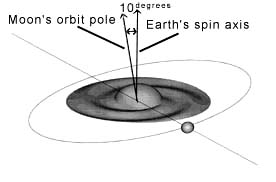| . |  |
. |
|
Boulder - February 16, 2000  The mysterious tilt of the moon's orbit is probably a natural consequence of the moon's formation from a giant collision with early Earth, according to a new study by scientists at Southwest Research Institute (SwRI).
The mysterious tilt of the moon's orbit is probably a natural consequence of the moon's formation from a giant collision with early Earth, according to a new study by scientists at Southwest Research Institute (SwRI).The moon's orbit can be traced backwards in time to reveal that when the moon formed near the Earth, its orbit was inclined by approximately 10 degrees relative to the Earth's equator. Most other planetary satellites in the solar system have orbital inclinations smaller than 1 or 2 degrees. The cause of the moon's large orbital tilt has long been a mystery. "The inclination problem had been one of the last remaining obstacles for the impact hypothesis of moon formation," says SwRI Institute Scientist Dr. William R. Ward. The widely favored "giant impact theory" proposes that a Mars-sized body collided with Earth 4.5 billion years ago, creating a hot disk of debris from which the moon accumulated. Previous models of the moon's formation from such a disk predict that the lunar orbit should have been nearly aligned with the Earth's equator, with only about a 1 degree tilt. The new theory, published in the February 17 issue of Nature, proposes that the moon acquired its large tilt soon after it formed because of a gravitational interaction with debris left over from the impact event. Modeling results presented in the paper, authored by Ward and SwRI planetary scientist Dr. Robin M. Canup, show that the moon could have acquired its 10 degree tilt as a consequence of the moon-forming impact. To yield a lunar-sized moon, the giant impact must place about two lunar masses of material into an Earth-orbiting disk, according to Canup. In the model, debris particles in the inner regions of such a disk are prevented from coalescing by Earth's gravity, which tends to pull objects apart. Instead, the moon rapidly coalesces at the outer edge of the debris disk, at a distance of about 14,000 miles from the Earth. "The newly formed moon would have likely co-existed for some time with an inner disk of gas and debris left over from the impact," says Canup. After the moon coalesced, its gravity would generate waves in the inner disk. The gravitational interaction of the moon with these waves would, in turn, modify the lunar orbit. The waves are launched at certain locations in the disk where the motions of disk particles are in resonance with the motion of the moon. The waves generated at one such resonance -- where the orbital period of the moon is approximately three times that of the disk particles -- are called "bending waves," which corrugate the surface of the disk. The gravitational attraction between the moon and these rippled waves in the disk then acts to amplify the tilt of the moon's orbit. Ward and Canup's model simulated the interaction of the moon and the inner debris disk, assuming that the moon formed in an orbit with only a 1 degree tilt. They found that the interaction of the moon with the bending waves it generates in such a disk can amplify the lunar inclination to values as high as 15 degrees before the disk dissipates. The required tilt of about 10 degrees can be achieved if the disk contained at least 25 to 50 percent of a lunar mass and persisted from decades to as long as a century. These values are consistent with those predicted by other models of the impact event. "This theory explains the moon's anomalous orbital tilt as a natural consequence of its formation from a giant impact event," says Ward. "Rather than producing conflicting evidence, the lunar inclination may now represent an additional corroboration of the impact event," agrees Canup.
TERRADAILY.COM
|
| |||||||||
| The content herein, unless otherwise known to be public domain, are Copyright 1995-2016 - Space Media Network. All websites are published in Australia and are solely subject to Australian law and governed by Fair Use principals for news reporting and research purposes. AFP, UPI and IANS news wire stories are copyright Agence France-Presse, United Press International and Indo-Asia News Service. ESA news reports are copyright European Space Agency. All NASA sourced material is public domain. Additional copyrights may apply in whole or part to other bona fide parties. Advertising does not imply endorsement, agreement or approval of any opinions, statements or information provided by Space Media Network on any Web page published or hosted by Space Media Network. Privacy Statement All images and articles appearing on Space Media Network have been edited or digitally altered in some way. Any requests to remove copyright material will be acted upon in a timely and appropriate manner. Any attempt to extort money from Space Media Network will be ignored and reported to Australian Law Enforcement Agencies as a potential case of financial fraud involving the use of a telephonic carriage device or postal service. |